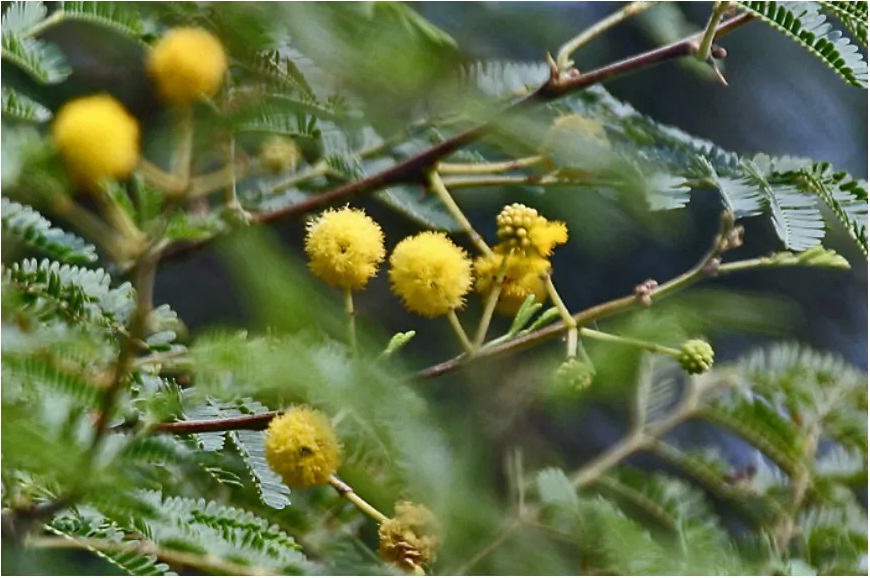Babool
Department of Botany
*Botanical name:- Vachellia nilotica
*Local name:-Babul, babool, prickly acacia, black piquant, egyptian acacia, indian gum arabic tree, gum arabic tree, thorn mimosa, thorny acacia, kikar, sant tree.
*Family - Fabaceae
*Commercial Uses: - Timber- The wood is widely used for construction as posts, rafters, beams and in door frames. It is one of the most favoured timbers for all types of agricultural implements like ploughs, harrows, crushers and rice pounders, and is extensively used in card building, for yokes, shafts, wheels.
Fuelwood- As a fuelwood, it is an excellent material and is also made into charcoal. Its charcoal is considered to be superior to charcoal from other species and body work.
Pulp and Paper- The wood from Acacias is good for paper and pulp making.
Gum- The gum obtained from A. nilotica is known as Indian Gum Arabic.
* Medicinal used –Treating Diarrhea
Babool is known to be useful in the treatment of diseases like diarrhoea. One can take three doses of 12 grams mixture of babool and cumin seeds (jeera). It is considered to be an effective medicine for the treatment of diarrhoea. It can be used either in decoction or in syrup.
It Can Heal Wounds-
The leaves and bark of Babool are quite beneficial for healing wounds. It has the ability to control the bleeding and infection which helps in healing wounds, cuts and injuries. Sprinkle Babool powder regularly on wounds for a speedy recovery.
Controls hair fall-
One of the benefits of Babool is that it controls hair fall. Its leaves are quite beneficial for the health of hair. Apply the paste of Babool on to your scalp to stop hair fall. For best results, after applying the paste wash it with a good quality shampoo. Wash your hair after 30 minutes of applying the paste and always use warm water to wash off.
Treats Teeth Disorders-
Babool not only treats the disorders of your teeth but also strengthens it. One of the best ways to cure all your teeth disorders is to chew the fresh bark of the babool tree. One can simply clean his/her teeth by brushing them daily with a powder in which 60 grams of charcoal of babool wood, 24 grams of roasted alum and 12 grams of rock salt have been included.
Skin Treatment-
Dry skin is a big problem during winter months and Babool leaves and bark help in getting rid of such problem. One can easily get relief from itching, by applying the paste of Babool leaves to the itching area. Due to its anti-inflammatory properties, many skin related problems can be treated by using Babool leaves. Moreover, it nourishes skin and gives it a shiny appearance. For having a refreshing bath, you can dip the leaves of Babool in your bath water.
Healing-
The healing property of Babool can heal wounds quickly. Prepare a fine powder by taking few tender Babool leaves. For speedy recovery, sprinkle Babool powder regularly on wounds.
Pregnancy-
One benefit of Babool leaves is that chewing them during pregnancy can enable a woman to deliver a baby with a glowing, fairer and clear skin. Although, you should always consult a doctor before starting to use it.
Dermalogical-
When it comes to skin disorders, Babool is very much effective and can also be used in the bath water for clearer skin. One can boil Babool leaves in water and take a steam of it to treat Eczema.
Anti-diarrheal-
Useful for treating diarrhoea and intestinal worms. It has infection preventing qualities, hence it prevents the growth of harmful bacteria in the digestive system.
*Environmental benefits - Soil-
Acacia nilotica mainly occurs in plains on flat or gently undulating ground and ravines. It grows best on the alluvial soils in riverain areas subject to periodic inundations.
Frost-
It is a frost tender species. In severe frost, small seedlings as well as large trees are affected.
Light-
Acacia nilotica is a strong light demander and is intolerant of suppression.
Climate-
This species occurs in tropical and sub-tropical regions of India. In its natural range the absolute maximum shade temperature varies from 400C to 47.50C.
The average annual rainfall in its normal habitat varies from 200 to 1270 mm.
The tree normally tolerates temperature range varying from 40C to 470C. For good development the optimum lower limit of rainfall is about 600 mm.


